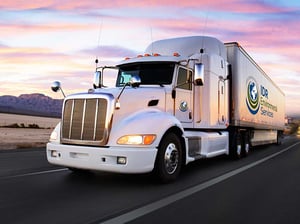A hazardous waste manifest is a critical document that tracks the lifecycle of hazardous materials from the point of generation to disposal at a destination facility, ensuring legal compliance and environmental safety.
However, despite its importance, it’s surprisingly easy to make errors in filling out or managing these forms. Even small mistakes—like mislabeling, incorrect waste codes or missing signatures—can lead to significant fines, regulatory violations or even legal liabilities for businesses.
With so many moving parts in the waste management process, attention to detail is vital, yet it's often where many companies falter.
In our Ebook “The Top 10 Hazardous Waste Violations and How to Avoid Them,” we discuss the major reasons why companies run afoul of the California Department of Toxic Substances Control (DTSC) and end up with regulatory fines.
The “low hanging fruit” for DTSC regulators is often improperly completed paperwork. The uniform hazardous waste manifest is a “document” that must accompany most hazardous waste that is shipped from your facility to an offsite disposal facility. Each party that handles the waste must sign the document and submit those copies to DTSC. This chain of custody reporting establishes the cradle-to-grave tracking required under hazardous waste legislation.
However, over the last few years, the hazardous waste manifest has undergone significant changes, primarily with the introduction of the EPA’s e-Manifest system. Launched in 2018, this digital platform replaced the traditional paper-based process, streamlining the tracking of hazardous waste shipments across the U.S.
The e-Manifest allows for real-time updates, reduces paperwork and minimizes the risk of errors. Since then, there have been ongoing improvements, including enhanced user interfaces and system integrations, making it easier for companies to comply with hazardous waste regulations. These updates have not only improved efficiency but also increased transparency and access to data for both large quantity generators and regulators.
Yet mistakes can happen. Here are some frequently asked questions about the hazardous waste manifest so that you can ensure this important process remains error free.
What Is The Most Common Mistake Made When Filling Out A Hazardous Waste Manifest?
One of the most common mistakes is failing to accurately identify the type of waste being transported. Incorrect waste codes or descriptions can cause delays, fines, or even rejection of the waste at disposal facilities. Additionally, forgetting to properly sign or date the form can lead to non-compliance.
codes or descriptions can cause delays, fines, or even rejection of the waste at disposal facilities. Additionally, forgetting to properly sign or date the form can lead to non-compliance.
Can I Still Use Paper Manifests, Or Do I Need To Switch To The E-Manifest System?
While the e-Manifest system is now the standard for tracking hazardous waste, paper manifests are still permitted in certain cases. However, any paper manifest must be uploaded to the e-Manifest system to maintain proper tracking. The U.S. Environmental Protection Agency (EPA) highly recommends that companies switch fully to the digital system to reduce errors and streamline the process.
In addition to minimizing the risk of manual errors, the e-Manifest system provides real-time tracking, faster processing and easy access to historical data for audits and inspections. It also enhances transparency by allowing both generators and regulators to monitor waste shipments more efficiently.
However, transitioning to a fully digital system may require staff training and process adjustments, especially for companies with longstanding paper-based workflows. Compliance with EPA's deadlines and guidelines is essential to avoid penalties, so companies should ensure they are familiar with both the electronic and paper submission requirements.
Who Is Responsible For Signing The Manifest?
Each party that handles the hazardous waste—whether it's the generator, transporter or disposal facility—must sign the manifest. This chain of signatures is crucial for maintaining the "cradle-to-grave" tracking of the waste, ensuring accountability throughout the process.
the manifest. This chain of signatures is crucial for maintaining the "cradle-to-grave" tracking of the waste, ensuring accountability throughout the process.
After the hazardous waste is transported, the generator must receive a copy of the completed manifest from the disposal facility within a specific time frame—typically 35 days. If the generator doesn’t receive the signed manifest in time, they are required to contact the transporter and facility to resolve the issue.
How Long Do I Need To Retain Copies Of The Manifest?
Federal regulations require that hazardous waste generators keep copies of the manifest for at least three years. Some states may have longer retention requirements, so it's important to verify the specific rules in your jurisdiction.
What Should I Do If I Discover An Error After Submitting A Manifest?
If an error is discovered, it's essential to correct it as soon as possible. The e-Manifest system allows for amendments, but delaying correction can result in regulatory issues. In cases where the waste has already been transported, notify the transporter or disposal facility to correct their records.
By paying close attention to these frequently asked questions, companies can avoid common pitfalls and ensure their hazardous waste manifests are error-free. Following best practices for completing and submitting manifests is key to maintaining compliance and avoiding costly penalties.
Other Important Information About Hazardous Waste Manifests
While the federal e-Manifest system is standardized, individual states may have additional regulations or reporting requirements. It’s important to be familiar with the hazardous waste laws in your state since failure to comply with state-specific rules can lead to penalties even if you're following federal guidelines.
Ensuring that all employees responsible for filling out, reviewing or handling hazardous waste manifests are properly trained is crucial. Lack of proper training is a common reason why mistakes happen. Regular refresher courses on hazardous waste documentation can help mitigate risks and keep your team updated on regulatory changes.
If there’s a discrepancy between the waste recorded in the manifest and what’s received at the disposal facility, this must be reported and addressed. These discrepancies could indicate miscommunication, inaccurate classification or other serious issues, which, if left unresolved, could result in penalties or investigations.
By staying proactive in understanding all aspects of hazardous waste manifest requirements and continuously updating compliance practices, businesses can reduce their risk and improve overall waste management efficiency.


Comment